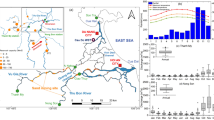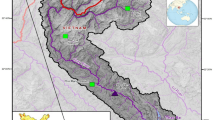Abstract
Whether mining activity results in reduced flow of surface water in the Peace River Watershed of Florida has been the subject of much debate. With increased dependence of downstream users on surface water flow of the Peace River as a source of drinking water for four coastal counties in Southwest Florida and problems of water security, the debate has been intensified. It is possible to assess relationships of mining with streamflow in the upper reaches of the Peace River Basin using hydrologic modeling and identify mined sub-basins. In this work, land-use change impacts were simulated by the Hydrological Simulation Program—Fortran (HSPF) model based on geographical information system (GIS) tools, to compare pre- and post-mining streamflows at a study site of the Peace River in west-central Florida. The purpose of this study was to determine if land-use changes caused by mining have negatively impacted streamflow in the Peace River. Changes of land use were identified before and after mining activities. A coupled volume-water depth-discharge (V-h-Q) model based on stage/storage and stage/discharge was applied using HSPF for the pre-mining and post-mining models, respectively. Daily simulated post-mining hydrographs from HSPF were plotted with the calibrated pre-mining results and streamflow hydrographs from the 18 gauging stations, to compare timing of peaks, low flows and flow trends. Analyses of percent exceedances of flow frequency curves of the streams indicated that most streams had similar distributions for mined (reclaimed) and premining periods. In the streamflow change analysis, streamflows actually increased in mining-affected basins at nearly half the stations. Streamflows at other stations diminished. Overall from this comprehensive study, there were declines in streamflow at most gauging stations on the mainstem of the Peace River and its tributaries. The results of this study suggest that regional planning is urgently needed to propose reclamation schemes that enhance regional hydrology.
Similar content being viewed by others
References
Antwi E K, Krawczynski R, Wiegleb G, 2008. Detecting the effect of disturbance on habitat diversity and land cover change in a post-mining area using GIS. Landscape and Urban Planning, 87(1): 22–32. doi: 10.1016/j.landurbplan.2008.03.009
Atabay S, Knight D, 1999. Stage-discharge and resistance relationships for laboratory alluvial channels with overbank flow. Proceedings of the 7th International Symposium on River Sedimentation. Hong Kong, 223–229.
Bicknell B R, Imhoff J C, Kittle J L et al., 2001. Hydrological Simulation Program—FORTRAN (HSPF): User′s Manual for Version 12. U.S. Environmental Protection Agency, Athens, GA. Available at: http://www.epa.gov/waterscience/basins/bsnsdocs.html.
Brown M T, 2005. Landscape restoration following phosphate mining: 30 years of co-evolution of science, industry and regulation. Ecological Engineering, 24: 309–329. doi: 10.1016/j.ecoleng.2005.01.014
Carlson T N, Arthur S T, 2000. The impact of land use-land cover changes due to urbanization on surface microclimate and hydrology: a satellite perspective. Global and Planetary Change, 25(1–2): 49–65. doi: 10.1016/S0921-8181(00)00021-7
Dawdy D, Lucas W, Wang W, 2000. Physical basis of stagedischarge ratings. Proceedings of the 8th International Symposium on Stochastic Hydraulics, Beijing, China, 561–564.
Diaz-Ramirez J N, McAnally W H, Martin J L, 2012. Sensitivity of simulating hydrologic processes to gauge and radar rainfall data in subtropical coastal catchments. Water Resource Manage, 26: 3515–3538. doi: 10.1007/s11269-012-0088-z
FIPR (Florida Institute of Phosphate Research), 2004. Reclamation of Phosphate Lands in Florida. Available at: http://www.fipr.state.fl.us/research-area-reclamation.htm.
Flannery M S, Peebles E B, Montgomery R T, 2002. A percentof- flow approach for managing reductions of freshwater inflows from unimpounded rivers to Southwest Florida estuaries. Estuaries and Coasts, 25(6): 1318–1332. doi: 10.1007/BF02692227
Green R C, Arthur J D, DeWitt D, 1995. Lithostratigraphic and Hydrostratigraphic Cross Sections Through Pinellas and Hillsborough Counties, Southwest Florida. Bartow, Florida: Open File Report-Florida Geology Survey 61.
Iskra I, Droste R, 2007. Application of non-linear automatic optimization techniques for calibration of HSPF. Water Environment Research, 79(6): 647–659. doi: 10.2175/106143007X156862
Jeon J H, Lim K J, Yoon C G et al., 2011. Multiple segmented reaches per subwatershed modeling approach for improving HSPF-Paddy water quality simulation. Paddy and Water Environment, 9(2): 193–205. doi: 10.1007/s10333-010-0218-2
Kelly M, Gore J A, 2008. Florida river flow patterns and the Atlantic multi decadal oscillation. River Research and Applications, 24(5): 598–616. doi: 10.1002/rra.1139
Lazareva O, Pichler T, 2007. Naturally occurring arsenic in the Miocene Hawthorn Group, southwestern Florida: potential implication for phosphate mining. Applied Geochemistry, 22(5): 953–973. doi: 10.1016/j.apgeochem.2006.12.021
Lewelling B R, Tihansky A B, Kindinger J L, 1998. Assessment of the Hydraulic Connection between Ground Water and the Peace River, West-Central Florida. USGS Water-Resources Investigations Report 97–4211. Tallahassee, Florida: U.S. Geological Survey, 16–27.
Lian Y Q, Chan I, Xie H et al., 2010. Improving HSPF modeling accuracy from FTABLES: a case study for the Illinois River Basin. Journal of Hydrologic Engineering, 15(8): 642–650. doi: 10.1061/(ASCE)HE.1943-5584.0000222
Schreuder P J, Earls J K, Dumeyer J M, 2006. Impact of Phosphate Mining On Streamflow. Water Resources & Environmental Consultants. Bartow, Florida: Florida Institute of Phosphate Research.
Scott T M, 1988. The Lithostratigraphy of the Hawthorn Group (Miocene) of Florida. Tallahassee, Florida: Florida Geology Survey 59.
Seibert J, McDonnell J J, 2010. Land-cover impacts on streamflow: a change-detection modelling approach that incorporates parameter uncertainty. Hydrological Sciences Journal, 55(3): 316–332. doi: 10.1080/02626661003683264
Siriwardena L, Finlayson B L, McMahon T A, 2006. The impact of land use change on catchment hydrology in large catchments: the Comet River, central Queensland, Australia. Journal of Hydrology, 326: 199–214. doi: 10.1016/j.jhydrol.2005.10.030
SWFWMD (Southwest Florida Water Resources Management District), 2001. Peace River Comprehensive Watershed Management Plan Volume II: Strategic Action Plan. Tampa, Florida: Water Management District, 23–56.
Wiegleb G, Felinks B, 2001. Predictability of early stages of primary succession in postmining landscapes of lower Lusatia. Applied Vegetation Science, 4(1): 5–18. doi: 10.1111/j.1654-109X.2001.tb00229.x
Xie H, Lian Y Q, 2013. Uncertainty-based evaluation and comparison of SWAT and HSPF applications to the Illinois River Basin. Journal of Hydrology, 481: 119–131. doi: 10.1016/j.jhydrol.2012.12.027
Zhang J, Ross M, Trout K et al., 2009. Calibration of the HSPF model with a new coupled FTABLE generation method. Progress in Natural Science, 19(12): 1747–1755. doi: 10.1016/j.pnsc.2009.07.006
Author information
Authors and Affiliations
Corresponding author
Additional information
Foundation item: Under the auspices of National Natural Science Foundation of China (No. 41271004), Beijing Municipal Science & Technology New Star Project Funds (No. 2010B046)
Rights and permissions
About this article
Cite this article
Zhang, J., Ross, M. Hydrologic modeling impacts of post-mining land use changes on streamflow of Peace River, Florida. Chin. Geogr. Sci. 25, 728–738 (2015). https://doi.org/10.1007/s11769-015-0745-2
Received:
Accepted:
Published:
Issue Date:
DOI: https://doi.org/10.1007/s11769-015-0745-2




